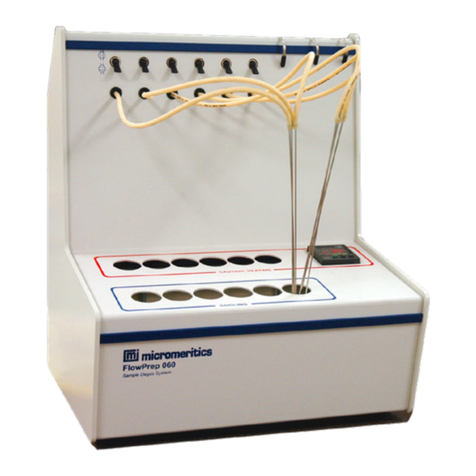
FlowSorb III Intended Use and Precautions
Precautions
Read all of the precautions contained in this section and observe them at all
times when operating the FlowSorb III.
General
•
Certain solids when heated give off corrosive vapors. Such vapors can
damage instrument components. The degassing feature of the FlowSorb is
intended primarily for the removal of adsorbed water vapor and non-con-
densible gases acquired through normal atmospheric exposure. Cleanup of
unusually contaminated samples should be accomplished prior to installa-
tion on the instrument. The DeSorb 2300A is available for this use as well
as for routinely speeding sample throughput.
•
The gas composition detectors are sensitive to the presence of oxygen
when turned on. The FlowSorb must be purged of oxygen by flowing an
inert gas, or mixture of inert gases, through it for at least five minutes be-
fore power is applied. This precaution applies especially when the instru-
ment is initially installed and after it has been stored for a period of time.
Should the inert gas supply be inadvertently depleted or somehow discon-
nected while the FlowSorb is in operation, the power should immediately
be turned off and the system purged of oxygen before reapplying power.
•
Unplug the power cord before removing the rear panel to gain access to in-
ternal components. Connections carrying potentials as great as 240 V can
be encountered.
•
While liquid nitrogen is the most commonly employed coolant, it is possi-
ble to use liquid argon and a variety of slush baths involving organic sol-
vents. These latter require special precautions. Be sure that no hot or
burning combustible material comes near either liquid argon or flammable
solvents. A lighted cigarette poses a particular hazard in both cases.
•
Do not invert a sample holder once powdered sample is placed in a sam-
ple tube and the tube is attached to the holder. Particles can lodge in the
quick-disconnect seals causing them subsequently to malfunction. Reten-
tion of particles in the mechanism also produces a sample weight error.
Should this happen, thoroughly clean the holder and reweigh the sample
before proceeding.
•
Do not detach from the FlowSorb a sample holder that contains a sample
at, or near, liquid nitrogen temperature and having gas still adsorbed on
the sample. The sample holder seals automatically upon removal and,
upon warming, previously adsorbed gas may be released, raising the pres-
sure in the holder to a dangerous level.




























